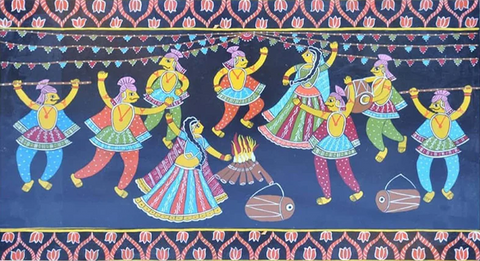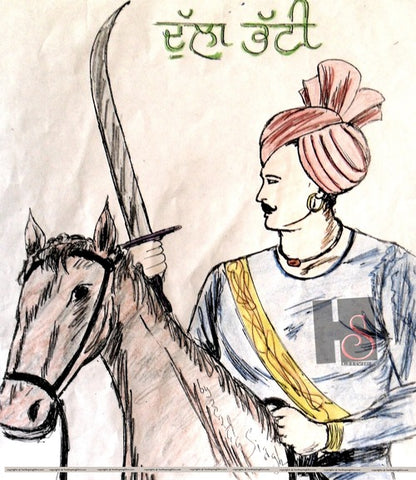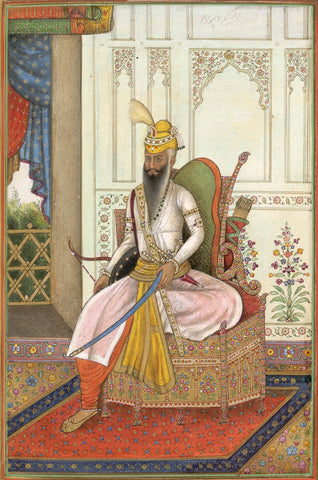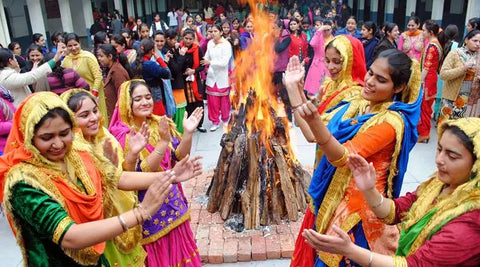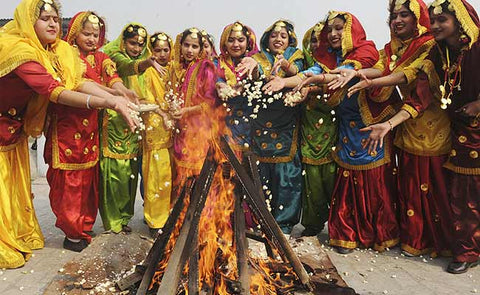Step back in time and immerse yourself in the enchanting folklore that gave birth to the lively celebration of Lohri. Discover the various stories that shaped the cornerstone of Punjabi culture associated with Lohri, from the legendary tale of Dulla Bhatti, a heroic figure whose spirit continues to dance in the flames of Lohri bonfires to the mystical origins embedded in the very name of Lohri.
Bonfires and Folklore
The tale of Dulla Bhati
Embark on a journey into the captivating origins of Lohri, where the heart of the celebration beats to the tales of Dulla Bhatti, an unlikely hero in the Punjab of Emperor Akbar's era. Dulla Bhatti, a Muslim highway robber, made an indelible mark by not only robbing the wealthy but emerging as a savior of Hindu girls destined for the slave markets of the Middle East. His noble acts included orchestrating marriages for these girls with Hindu rituals and providing them with dowries. Despite his outlaw status, Dulla Bhatti became a legendary figure, a hero embraced by all Punjabis, earning expressions of gratitude in every resonating note of a Lohri song.
Dulla Bhatti
As the first week of January rolls in, small groups of enthusiastic boys become the modern-day messengers of Dulla Bhatti. Armed with vibrant voices and contagious energy, they embark on a unique quest, ringing doorbells and filling the air with the rhythmic beats of Lohri songs echoing the tales of this legendary hero.
Picture this: the doorstep becomes a stage, and the boys become minstrels of the Lohri lore. Their voices rise and fall like the undulating flames they sing about, recounting the valorous escapades of Dulla Bhatti. The narrative unfolds in a melodic dance, captivating the hearts of those who listen. But it's not just about the songs; it's a festive exchange, a delightful ritual. As the verses weave tales of Dulla Bhatti's bravery, the people reciprocate with gifts. Popcorn, peanuts, the sparkle of crystal sugar, the earthy richness of sesame seeds (til), and the sweetness of gur (jaggery) are bestowed upon the young troubadours, and the jingling sound of coins that join this symphony of generosity.
Turning these young bards away empty-handed is more than a simple refusal; it's a dance with the fates, a touch of inauspiciousness. So, with laughter and merriment, the exchange continues, creating a bond that transcends generations.
In the heart of this charming tradition lies a connection to the past, a vibrant thread linking the present to the valorous tales of Dulla Bhatti. Lohri, thus, becomes not just a festival but a living, breathing testament to the stories that shape our celebrations and infuse them with the spirit of camaraderie, joy, and a touch of magical folklore.
Etymology
The very name "Lohri" has its roots entwined in various captivating legends. Some believe it pays homage to Loi, Sant Kabir's wife, while others trace it back to the Punjabi pronunciation of "Lohi." Another intriguing tale weaves a connection between Lohri and the word 'loh,' a sturdy iron sheet used for communal feasts. Additionally, a narrative of sisters, Holika and Lohri, adds an element of mystique. While Holika succumbed to the Holi fire, Lohri endured, giving rise to a celebration intertwined with resilience and survival. The consumption of sesame seeds (til) and jaggery (rorhi) becomes a sacred tradition, possibly evolving from the amalgamation of these words into "tilorhi" and eventually shortening to "Lohri."
Historical significance
Historical richness of Lohri, finds echoes of its celebration even in the grand Lahore Darbar during Maharaja Ranjit Singh's reign. The opulence of the festivities is depicted in the vibrant yellow trousseau of Maharaja Ranjit Singh and the royal orders for attendants to attire themselves in a similar hue. As a gesture of benevolence, the Maharaja bestowed robes of honor upon chieftains, vakils, and nobles during the Lohri celebrations.
Maharaja Ranjit Singh
Beyond a mere festival, Lohri is a fervent celebration of Punjab's industry and culture, resonating with exuberance. The festival, coinciding with Pongal and Makar Sankranti, collectively conveys a message of gratitude to the Almighty for the abundance bestowed upon the earth. In its historical and cultural tapestry, Lohri stands as a vibrant testament to the spirit of thanksgiving and communal joy.
Traditions of Lohri
The Lohri festivities are a tapestry of vibrant ceremonies. The festivities extend to a melodic realm with the enchanting notes of folk songs echoing through the air. In the heartland of Punjab, Lohri transcends into a grand celebration, marked by fairs that draw people from far and wide. Races, wrestling bouts, soulful singing, awe-inspiring acrobatics, engaging games, and delectable food stalls converge to create an immersive experience, making Lohri not just a festival but a vibrant carnival of joy and togetherness. Lohri, a jubilant celebration of fertility and the zest for life, takes on an even grander scale in moments of familial joy such as the birth of a male child or a wedding. During these occasions, the host family orchestrates a joyous feast. The significance of Lohri is amplified during the first celebration for a new bride or a newborn. It marks a momentous occasion, symbolizing not only the continuity of life but also the beginning of new chapters within the family.
Women performing gidda around Lohri
Crafting a small image of the Lohri goddess with cattle dung, adorning it, and igniting a fire beneath it initiates the celebrations. The air is filled with chants praising the goddess. As the sun sets, a grand bonfire is lit, and sesame seeds, gur, sugar-candy, and rewaries are tossed into the flames. Gathered around the warmth, people sing and dance until the fire wanes. The remnants of the fire, carried home, symbolize the spirit of Lohri, connecting households with the shared celebration. In Punjabi villages, fires are kept ablaze continuously using cow-dung cakes, creating a rhythmic heartbeat that resonates through the night.
Women offering popcorn, rewari, sesame seeds to the Lohri
In these cherished moments, Lohri becomes a vibrant canvas where the threads of tradition, celebration, and familial bonds intertwine, creating an unforgettable tapestry of joy and cultural richness.
Thus, Lohri transcends time, weaving together tales of heroism, survival, and communal celebration into the fabric of Punjabi culture.
REFERENCES
“Lohri: Honouring the Harvest.” INDIAN CULTURE. Accessed January 11, 2024. https://indianculture.gov.in/food-and-culture/food-festivals/lohri-honouring-harvest.
NavTimes न्यूज़. “Significance of Lohri.” NavTimes न्यूज़, January 4, 2024. https://navtimesnews.com/lohri-significance/.
Vedantu. “Everything You Need to Know about the Festival of Bonfire.” VEDANTU, December 27, 2023. https://www.vedantu.com/blog/lohri-festival-celebrations
“Lohri.” Lohri - SikhiWiki, free Sikh encyclopedia. Accessed January 11, 2024. https://www.sikhiwiki.org/index.php/Lohri.

